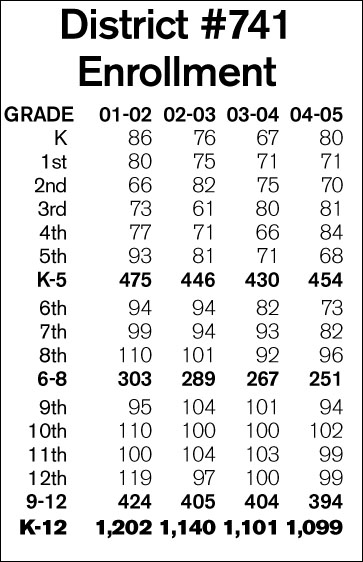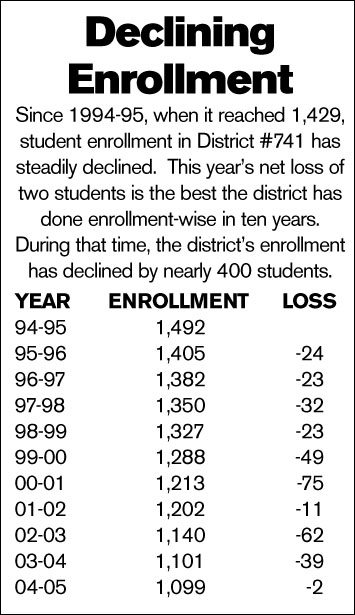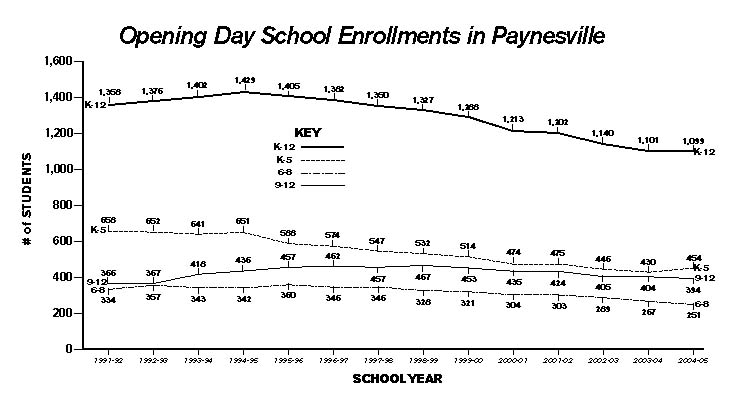Student enrollment holds steady in district
 District enrollment on opening day last year (2003-04) was 1,101. District enrollment on opening day this year (2004-05) was 1,099.
District enrollment on opening day last year (2003-04) was 1,101. District enrollment on opening day this year (2004-05) was 1,099.
"That's very good news," said new superintendent Todd Burlingame. "Every year we've been dropping 25 or 30 students."
Since 1994-95, when district enrollment peaked at 1,429, the district has steadily lost students, as many as 75 students in 2000-01 and losing 62 students as recently as 2002-03. This year's enrollment numbers are the closest the district has come to holding steady since 1994-95. (Previously it's smallest enrollment decline in the past ten years was a drop of 11 students in 2001-02.)
This year, the district lost 100 students to graduation, who were replaced by 80 students in kindergarten, a net loss of 20. The district also lost two additional students entering grades 9-12 this year, a total net loss of 22.
But that decline was offset by an increase in enrollment of 15 students in grades 1-5 and an increase in enrollment of five students in grades 6-8. For instance, last year's second grade class was 75 but added six students this year in third grade. Other grades that gained enrollment were first grade (up four), fourth grade (up four), fifth grade (up two), sixth grade (up two), and eighth grade (up three).
The district, however, still appears headed toward a student population closer to 1,000 (75 students per grade) than 1,300 (100 students per grade). In fact, only one grade in the district has an enrollment over 100; tenth graders number 102 this year.
With students in grades 1-6 worth nearly $5,000 apiece per year in state aid and students in grades 7-12 worth nearly $6,000 apiece (due to a higher weighted value), declining enrollment translates into declining revenue for the district.
 The district still faces declining state aid this year even though its enrollment basically held steady. This is because its smaller grades are now entering 7-12, where state aid is weighted at 1.3 per student. Last year, the district's 7-12 population was 589, worth approximately $3.52 million in state aid. This year, its 7-12 population (having lost 100 seniors, replaced by 82 seventh graders) is down to 572, worth approximately $3.42 million in aid, a decline of $100,000.
The district still faces declining state aid this year even though its enrollment basically held steady. This is because its smaller grades are now entering 7-12, where state aid is weighted at 1.3 per student. Last year, the district's 7-12 population was 589, worth approximately $3.52 million in state aid. This year, its 7-12 population (having lost 100 seniors, replaced by 82 seventh graders) is down to 572, worth approximately $3.42 million in aid, a decline of $100,000.
"We get more dollars for those kids in grades 7-12. Now those smaller classes from the elementary are going to appear in the middle school and high school," explained Burlingame.
Overall, the district's 2004-05 enrollment - despite a decline of only two students - should mean a decline in basic state foundation aid of nearly $60,000. Kindergarten aid (weighted at 0.557 per student) is up nearly $30,000, thanks to having 80 kindergartners this year; grade 1-3 aid (weighted at 1.15 per student) is down $20,000, due to a four-student drop; and grade 4-6 aid is up $30,000, due to a six-student increase.
While the enrollment numbers are good news, it does not mean the district can stop its planned budget reductions, said Burlingame. District spending still needs to be reduced in accordance with its declining revenue, he emphasized.
Right now, the district projects another $250,000 in budget reductions for the next school year (2005-06). If enrollment numbers stay strong and if the annual audit this fall (revealing final financial figures from the last year) is better than budgeted, the district might be able to cut less than expected, said Burlingame.
The projected cuts were based on an estimated student enrollment of 1,060 for 2004-05, when the actual enrollment started at 1,099.
That still could change, though, as students are more mobile these days, transferring between schools during mid-year. Hopefully, the trend of adding students will continue, said Burlingame, by providing a quality education to district students, by keeping students happy, and by keeping students here.
Smaller budget reductions (which the district has used the past two years) can be made through attrition (not replacing retiring teachers instead of layoffs) and are much less painful than large-scale budget reductions, said Burlingame. The budget cuts the district had to do a couple years ago, when it cut $1 million in spending over two years, were painful and not fun, Burlingame said.
The district needs to continue to be financially responsible to avoid those kinds of cuts again, which means continuing to reduce its budget to reflect declining revenue, he said.
The district still wants to have an eight percent balance in its general fund - one month of expenses or roughly $700,000. As of July 2003, the district had only $260,800 in a general fund balance. (Its July 2004 balance will not be known until the completion of its audit this fall.)

Contact the author at editor@paynesvillepress.com • Return to News Menu
Home | Marketplace | Community